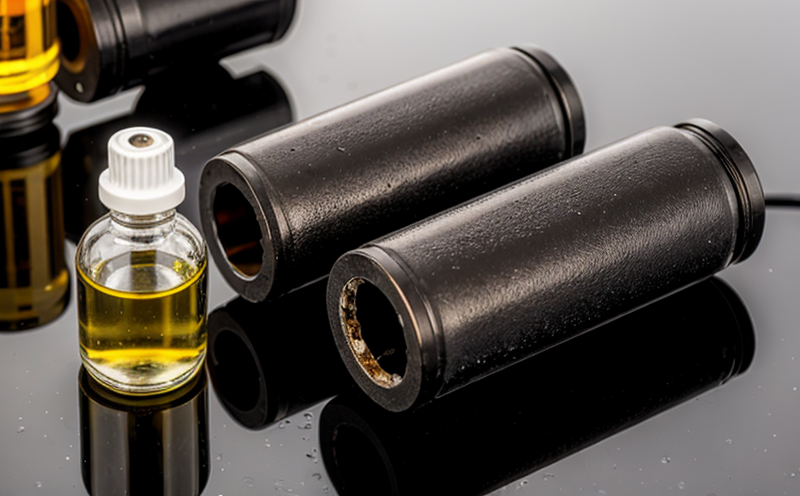EPA 413.2 Oil and Grease Freon Extractable Test in Water
The EPA 413.2 test method is designed to measure the concentration of oil, grease, and hydrocarbons that are extractable with a freon solvent from water samples. This analytical approach helps environmental professionals understand the extent of contamination in aquatic environments, which is critical for compliance with regulatory standards and for R&D in pollution mitigation strategies.
The test involves several key steps: sample collection, preparation, extraction using a freon solvent, filtration, evaporation, and finally, the determination of oil and grease content by gravimetric or volumetric methods. The primary focus is on identifying hydrocarbon compounds that are soluble in chloroform, which are known to be detrimental to aquatic life.
The EPA 413.2 test is particularly relevant for industries such as petrochemicals, refineries, and other facilities that discharge process waters into receiving streams or municipal sewers. By detecting these hydrocarbons, the test aids in determining appropriate treatment processes and monitoring compliance with environmental regulations.
The methodology aligns closely with international standards like ISO 9408 and ASTM D2709, which provide additional context for the extraction process and analysis techniques used. The use of freon as an extractant is significant because it allows for the separation of hydrocarbons that are not miscible in water but can dissolve in organic solvents.
The test results are reported in mg/L (milligrams per liter) or ppm (parts per million), depending on the scale and sensitivity required. These units help stakeholders understand the extent of contamination relative to acceptable limits set by regulatory bodies like the EPA.
Preparation of samples is critical for accurate results. Samples should be collected in appropriate containers that minimize contamination, typically using a 1-L glass container with a Teflon-lined cap. The sample must then be filtered through pre-combusted filter paper to remove particulate matter before extraction. After extraction with freon, the solvent is evaporated under reduced pressure, leaving behind the extractable hydrocarbons.
The gravimetric method involves weighing the residue after evaporation and calculating its weight in relation to the original sample volume. Alternatively, volumetric methods can be used for more precise measurements of smaller concentrations. Both methods provide valuable data on the presence and quantity of oil and grease that are extractable with freon.
Understanding the specific application of this test method is important for quality managers, compliance officers, R&D engineers, and procurement personnel. By ensuring accurate testing and reporting, stakeholders can make informed decisions about pollution control measures, treatment processes, and regulatory compliance strategies.
Applied Standards
- EPA Method 413.2: This method is specifically designed for the determination of oil and grease in water samples using freon extraction. It provides detailed procedures for sample preparation, extraction, and analysis.
- ISO 9408: International standard that specifies the procedure for determining the content of extractable hydrocarbons in water by solvent extraction. This aligns closely with EPA Method 413.2.
- ASTM D2709: American Society for Testing and Materials' standard practice for determination of oil and grease in water by gravimetric or volumetric methods, which supports the EPA method's results interpretation.
International Acceptance and Recognition
EPA Method 413.2 is widely recognized globally for its robustness in measuring oil and grease in water samples. It has been accepted by numerous regulatory bodies, including the European Union (EU) and other national environmental authorities worldwide.
- European Union: The EU Directive 91/271/EEC on urban waste water treatment includes reference to EPA Method 413.2 for monitoring oil and grease in municipal wastewater.
- International Organization for Standardization (ISO): ISO standards like ISO 9408 are often aligned with EPA methods, including 413.2, providing a harmonized approach to hydrocarbon analysis across different jurisdictions.
The method's acceptance is further bolstered by its simplicity and reliability in detecting extractable hydrocarbons that can impact water quality. Compliance with this test ensures that industries are meeting international standards for environmental protection.
Use Cases and Application Examples
- Municipal Sewer Systems: EPA Method 413.2 is used to monitor the quality of effluent water from municipal wastewater treatment plants, ensuring that discharge limits are not exceeded.
- Petrochemical Plants: This test method helps in assessing the effectiveness of oil and grease removal processes before they reach receiving waters.
- Industrial Facilities: Industries like refineries and chemical plants use this method to ensure compliance with environmental regulations by regularly monitoring their effluent water for hydrocarbon content.





